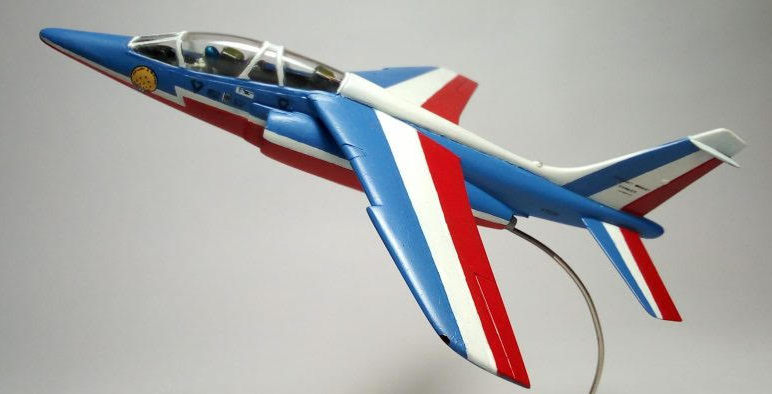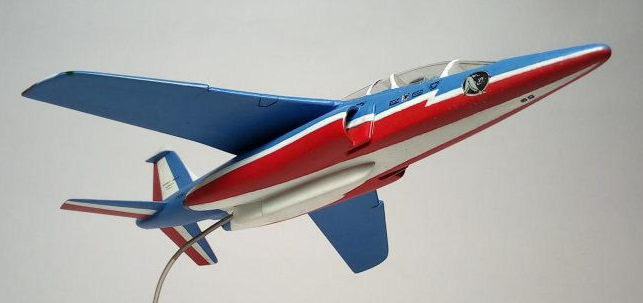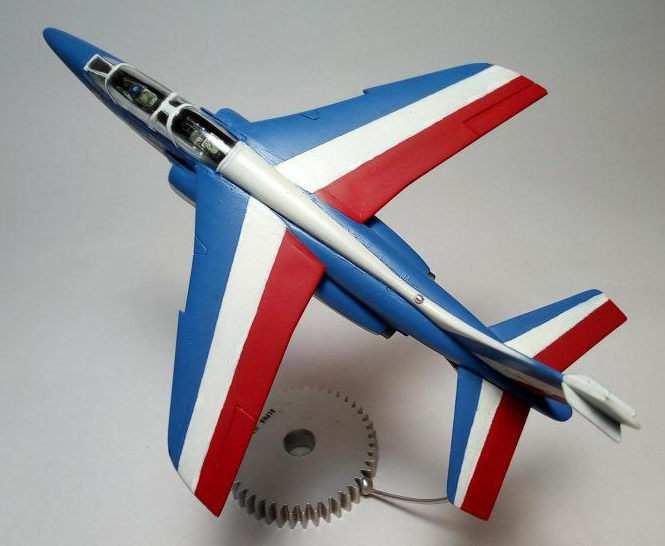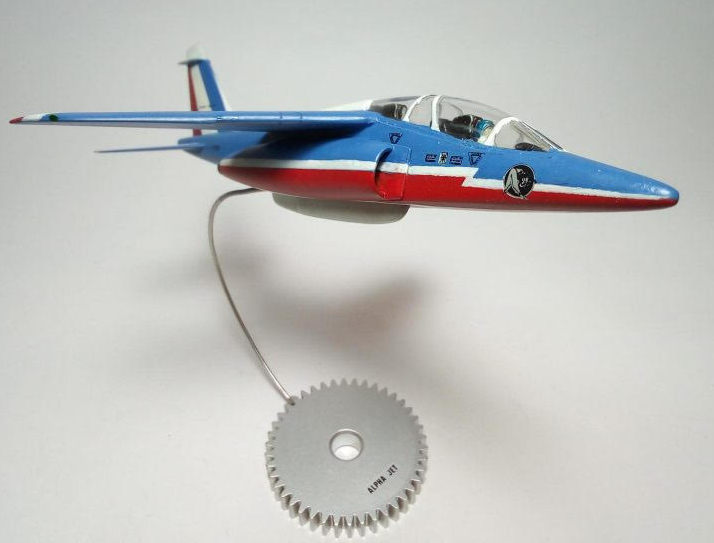
| KIT #: | 80257 |
| PRICE: | 5 Euros (2004) |
| DECALS: | one option |
| REVIEWER: | Spiros Pendedekas |
| NOTES: | Stand model |

| HISTORY |
The Dassault/Dornier Alpha Jet is a light attack jet and advanced jet trainer co-manufactured by Dassault Aviation of France and Dornier Flugzeugwerke of Germany. It was developed specifically to perform trainer and light attack missions, as well as to perform these duties more ideally than the first generation of jet trainers that preceded it.
 Both the
French Air Force and German Air Force procured the Alpha Jet in large numbers,
the former principally as a trainer aircraft and the latter choosing to use it
as a light attack platform. As a result of post-Cold War military cutbacks,
Germany elected to retire its own fleet of Alpha Jets in the 1990s and has
re-sold many of these aircraft to both military and civilian operators. The
Alpha Jet has been adopted by a number of air forces across the world and has
also seen active combat use by some of these operators.
Both the
French Air Force and German Air Force procured the Alpha Jet in large numbers,
the former principally as a trainer aircraft and the latter choosing to use it
as a light attack platform. As a result of post-Cold War military cutbacks,
Germany elected to retire its own fleet of Alpha Jets in the 1990s and has
re-sold many of these aircraft to both military and civilian operators. The
Alpha Jet has been adopted by a number of air forces across the world and has
also seen active combat use by some of these operators.
The Patrouille Acrobatique de France ("French Acrobatic Patrol"), also known as the Patrouille de France (PAF), is the precision aerobatics demonstration unit of the French Air and Space Force, officially commissioned in 1953.
Using the French Aerial Aerobatics (French: Voltige Aérienne Française) unit of the French Air and Space Force, the mission is to represent it and lead the ambassadorship role of French aeronautics overseas.Stationed at Aerial Base 701 Salon-de-Provence in Bouches-du-Rhône, it is the oldest (active since 1931) and considered as one of the best in the world. Comprising 9 pilots and 35 mechanics, the patrol (La Patrouille) splits its time between winter season (saison hivernale) training and summer season (saison estivale) aerial displays.
| THE KIT |
I bought this kit back in 2004 from a bookstore of a small Greek town on my way to holidays, together with a couple of other Heller/Airfix kits that seemed to be forgotten there, at a price of 5 Euros each. The specific kit is the 1997 reboxed edition of the original 1977 mold and comes in a very attractive top opening box, with a dramatic boxart painting, depicting a “Patrouille de France” Alpha Jet in inverted flight.
Upon opening the box, you are greeted with three good quality silver styrene sprues and a clear canopy. Sadly, all are loose in the box, meaning potential scratches (especially the canopy) and detachments from their trees. Molding is the usual good sweet Heller molding, with just a tad of flash here and there. All panels are raised, with the exception of aileron and rudder hinge lines, which are more correctly depicted as recessions.
 Cockpit is
simplistic, with two average looking Martin Bakers, flat instrument panels, two
control sticks, two pilots sans their feet (their feet couldn’t be seen in that
dark cockpit anyway…) and two good looking dashboards.
Cockpit is
simplistic, with two average looking Martin Bakers, flat instrument panels, two
control sticks, two pilots sans their feet (their feet couldn’t be seen in that
dark cockpit anyway…) and two good looking dashboards.
The landing gear legs and wheels are well represented, but no details are molded in the wheel wells. All parts are there to build any version of the Alpha Jet (smoke generator included).
Decals are for a single example of a “Patrouille de France” bird, with the livery worn at about the middle of the 90’s. Some white “detail” parts of the intricate camo are provided as decal pieces; using them might make masking a bit easier, however there’s the risk of tonal difference with the painted white. The decals are the usual Heller/Airfix decals of the 2000s, meaning some color layers shifting, which is a tad noticeable at the two round Squadron badges. The instructions are nice and clear, provided as a one side printed color pamphlet.
I opted to build this kit as a desktop wheels up model, attached to a custom base in a “dynamic” flight position and send it (from Greece) as a surprise present to a great French friend who lives in Bordeaux.
| CONSTRUCTION |
This was going to be a wheels-up Alpha Jet, so, I first attached the doors onto the fuselage halves, followed by gluing pieces of styrene form the inside, in order to be held firmly into place.
The two fuselage pieces were glued together, then inserted the cockpit tub underneath and glued it in place, followed by the under fuselage part and the characteristic smoke generator pod. There is a small recessed air intake at the smoke generator front that I micro drilled for more realistic looks.
 The wings are
a two piece affair each and were assembled as well. The fit of the wings to the
fuselage presented large gaps, so, they were attached with liquefied styrene
that oozed out of the gaps, acting also as filler. The rear stabilizers were
glued on too, as well as the gear doors, the finlets and the cockpit consoles.
The wings are
a two piece affair each and were assembled as well. The fit of the wings to the
fuselage presented large gaps, so, they were attached with liquefied styrene
that oozed out of the gaps, acting also as filler. The rear stabilizers were
glued on too, as well as the gear doors, the finlets and the cockpit consoles.
The bulbous mini nose was lost somewhere (I think my little son is responsible…..). No worries, as this kit contains all parts to build all versions; so I glued the pointy German version nose on and sanded it to shape. The air intakes, consisting of two parts each, were attached too. Some careful fitting will definitely pay off here! Also, since they are shallow with no intake trunking, I painted the “back plate” matt black to give the illusion of dark intake trunking.
After curing, the whole model was given an initial coarse sanding to even things, followed by generous amounts of Humbrol filler, in order to cover the remaining gaps and a couple of sink marks at the wing roots. After a progressive 320 to 1500 grit sanding, I headed to the paint shop.
| COLORS & MARKINGS |
“Patrouille de France” birds sport a striking three color camo with blue, white and red stripes as per the French Flag. It is unmistakable for sure, but it’s not the easiest scheme to replicate. There are some white decal pieces provided for some intricate areas, but, fearing color and shape mismatches, I decided to go fully painted. Since the hardest part would be to obtain those superfine zigzagged white lines, I decided to break the modeling paint rules and apply the white last! So, I first sprayed the red (Humbrol 60) and, after a protective coat of Future, I masked it off. I then sprayed the lovely French Blue (Humbrol14), which was afterwards masked as well, and finally the white (Humbrol 130).
Upon unmasking, I noticed that there was some buildup of white paint at the
masking borders. Also, many areas needed retouching. So, I first gave the whole
model a good coat of Future to act as a protective layer. Then, I extremely
carefully sanded down the paint buildups with 1500 grit. Once satisfied, armed
with my 10/0 Springer Pinsel paintbrush and a lot of patience, I went off to the
touchup iteration proc ess,
meaning quite a few loops of white, red and blue fine painting. A point arrived
where the looks were acceptable, which was a good point to stop retouching.
ess,
meaning quite a few loops of white, red and blue fine painting. A point arrived
where the looks were acceptable, which was a good point to stop retouching.
After another coat of Future, I went on and painted the cockpit black, adding some silver, red and yellow “details” to the otherwise totally blunt instrument panels.
It was then time for decaling. Heller (and the then sister Airfix) decals of that time suffered from registering problems (mainly color shift), the particular sheet been no exception. Luckily, the “Patrouille de France” uses minimal decaling, mostly in one color (black), so no shift problems here, with only the two nose unit badges suffering (but not that much). Being 20 years old decals, they took a full two minutes soaking in hot water to detach, but behaved well afterwards, yours truly being extra careful in handling as to avoid breakage. A coat of Future sealed them.
It was then time to paint my pilot (usually only one pilot was flying during aerobatic performances, the back seat being empty). “Patrouille de France” pilots wore and still wear a nice light blue flying suit, white scarf and green anti-g pants. As for the helmets, some variations occur, but usually metallic blue painted ones are worn. So this is how I painted him, also depicting the seat belts and survival pack belts in linen and yellow respectively.
The Martin Baker seats representation is on the simple side, the instructions calling to paint them black. Since they will be quite visible (especially the rear “empty” one, I decided to beef them up, by painting the body and head cushions, as well as the top parachute cover an olive green, adding seat belts (only at the back one) and parachute restrain belts at the head cushions. I then installed them in the cockpit, followed by the control sticks (painted black) and the pilot at the front. No gunsight was provided, but none was needed, as “Patrouille de France” flew (and I think still flies) sans them.
It is true that “Patrouille de France” birds are gloss (and meticulously clean, of course!). However, to my eyes, a totally gloss coat in 1/72 looks a bit unreal (but, then again, it’s only me…). So, the whole model was then given a “gloss towards satin” coat (Humbrol 80/20 gloss/matt).
| FINAL CONSTRUCTION |
 It was then
canopy time, which is thick but clear. Its frames were hand painted, according
to the scheme and it was attached to the model. Fit was not that great, as it
was narrower than the fuselage opening. I faired it with white glue as best as I
could and retouched where needed. A coat of Future at its transparent sections
(with a #1 paintbrush) gave the canopy that extra shine.
It was then
canopy time, which is thick but clear. Its frames were hand painted, according
to the scheme and it was attached to the model. Fit was not that great, as it
was narrower than the fuselage opening. I faired it with white glue as best as I
could and retouched where needed. A coat of Future at its transparent sections
(with a #1 paintbrush) gave the canopy that extra shine.
I added the wingtip lights with blobs of Humbrol clear red and green and my Alpha Jet was ready to be mounted at its base, which is an aeroengine gear, with a stainless steel wire welded on and bent accordingly. To mount it, I carefully drilled a hole at the back end of the smoke generator and inserted the wire well in. I applied the “ALPHA JET” decal from the decal sheet on top of the gear, to make it look more “official”.
As a note, since this is going to be a desktop model, I deliberately elected not to attach the characteristic, but fragile, underwing moving surfaces hinges and also the small dorsal antenna. I then called this French beauty done!
I detached it from its base and, along with some Greek delicatessen, packed everything carefully in a box and off to France!
| CONCLUSIONS |
I have always thought 1/72 Hellers to be sweet kits, relatively easy and pleasing to build. I was not disappointed! The kit looked nice in the box and with the consistent instructions went together easily. Fit was average but manageable, with the exception of the canopy that is too narrow. Should I build another Heller Alpha Jet, I would finish the cockpit and attach the canopy prior to filling and sanding, in order to obtain a smooth joint.
 The “Patrouille
de France” scheme is wonderful, but not the easiest to replicate, so be prepared
for some more than usual masking. Mounting it to a base resulted in an imposing
dynamic flying posture. The omission of the fragile wing hinges and dorsal
antenna simplified the looks a tad, but resulted in less sensitivity to
accidental mishandlings, a nice-to-have feature of a desktop model. Should you
decide to build it wheels down, the result will be equally imposing, as George
Schembri’s nice result here.
It took me about 10 working hours to finish it, quite a few of them spent as
“masking quality time”.
The “Patrouille
de France” scheme is wonderful, but not the easiest to replicate, so be prepared
for some more than usual masking. Mounting it to a base resulted in an imposing
dynamic flying posture. The omission of the fragile wing hinges and dorsal
antenna simplified the looks a tad, but resulted in less sensitivity to
accidental mishandlings, a nice-to-have feature of a desktop model. Should you
decide to build it wheels down, the result will be equally imposing, as George
Schembri’s nice result here.
It took me about 10 working hours to finish it, quite a few of them spent as
“masking quality time”.
Taking into account the above considerations, I would recommend this kit to all modelers, including younger ones that might even decide to hand paint it! And there are many other nice schemes as well. Of course, no one would object to having a new tool 1/72 kit of this amazing plane, but, in the meantime, the Heller kit will produce a nice representation of this beautiful, petite and important plane. It is frequently reissued by Heller, so locating one will not be such a problem.
Happy Modeling!
| REFERENCES |
Wikipedia
https://www.
Various internet sites (pics, info and models built)
11 May 2021
Copyright ModelingMadness.com. All rights reserved. No reproduction without
express permission. If you would like your product reviewed fairly and fairly quickly, please
contact
the editor or see other details in the
Note to
Contributors. Back to the Main Page
Back to the Review
Index Page
Back to the Previews Index Page